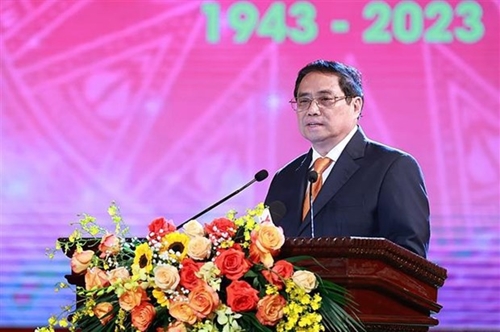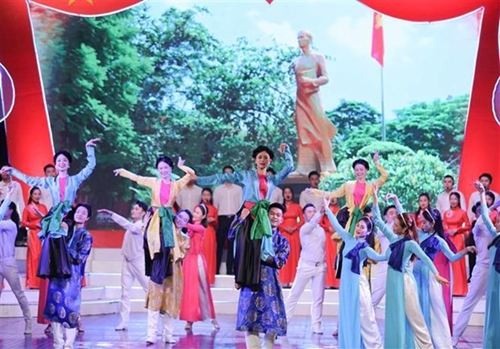Directed by the Ministry of Culture, Sports and Tourism and co-hosted by the Party Central Committee’s Commission for Information and Education and Vietnam Television (VTV), the event was televised on the VTV1 channel.
In his opening speech, Prime Minister Pham Minh Chinh recalled that 80 years ago when the semi-feudal colonial regime deteriorated, the Outline of Vietnamese Culture, drafted by Party General Secretary Truong Chinh, was approved by the CPV Central Committee’s Standing Board in February 1943, becoming the first official document on culture of the CPV.
    |
 |
|
Prime Minister Pham Minh Chinh speaks at the event. |
Over the past eight decades, the Outline of Vietnamese Culture has been applied flexibly, creatively, effectively by the CPV for national construction and defense, he said, adding that Vietnamese culture, literature, and arts have become sharp weapons on the ideological front. The Vietnamese culture is gradually reaching out to the world with many unique products and values that are highly respected and welcomed by international friends.
The Prime Minister suggested further enriching contents in the Outline of Vietnamese Culture and effectively performing the Party and State’s policies and laws, and Party General Secretary Nguyen Phu Trong’s directions at the National Cultural Conference like “Culture must be put on par with economy, politics and society,” “Culture is the spiritual foundation of society, both the goal and the inherent strength, and an important driving force for national development.”
According to the government leader, it is a must to continue renewing the Party leadership and improving the efficiency and effectiveness of State management on culture, invest in the rapid and sustainable development of culture, build the national value system, cultural values and human standards that are closely linked to preservation and development of Vietnamese family values in the new era.
He requested building a healthy cultural environment to serve citizens, developing a digital cultural environment that is appropriate to the digital economy, society and citizenship amid the fourth industrial revolution; and study international experience to develop cultural and entertainment industry that suit Vietnam's realities.
The Prime Minister also asked for popularizing Vietnam’s tangible and intangible cultural heritage that possess competitive advantages in the world such as Ha Long bay, Hoi An ancient city, Phong Nha - Ke Bang, Bac Ninh love duet singing, Then singing, and Thai dances, among others.
Under the theme “Outline of Vietnamese Culture – Historical imprints,” the 70-minute event comprised three parts praising the Party, President Ho Chi Minh, the nation and its culture.
    |
 |
|
A performance at the event |
It saw performances by artists of the Vietnam Contemporary Art Theater in collaboration with the Central Science and Documentary Film Studio, the Vietnam National Academy of Music, the Vietnam Dance Academy, the Ministry of Public Security’s drum troupe, the Ministry of National Defense’s ritual art troupe, the Hanoi University of Culture and the National University of Arts Education.
In 1943, by applying Marxism and the guidelines of the Party and leader Nguyen Ai Quoc, Party General Secretary Truong Chinh wrote the Outline of Vietnamese Culture (also known as the 1943 Outline on Culture), stressing that the content, nature, organization and development orientation of a cultural revolution can only be associated with the national liberation revolution and a cultural revolution can be realized when the political revolution has succeeded.
The document defined that Vietnamese culture, consisting of ideology, learning, and arts, “will be liberated by the democratic revolution and freed from shackles and could catch up with the world's neo-democratic culture.”
Source: VNA